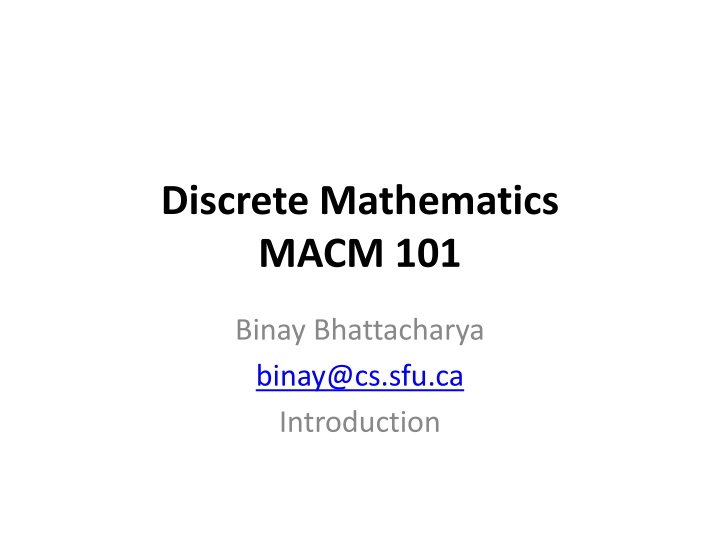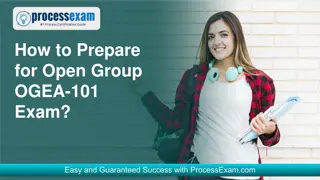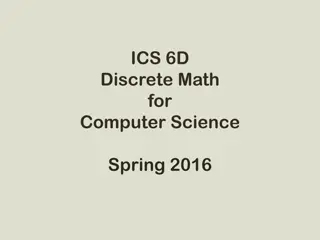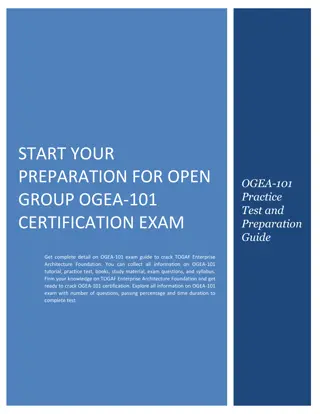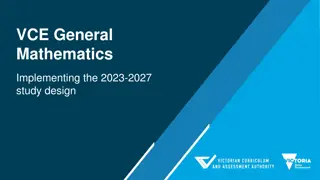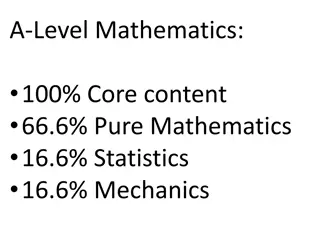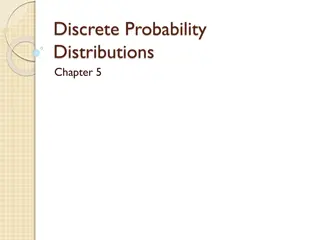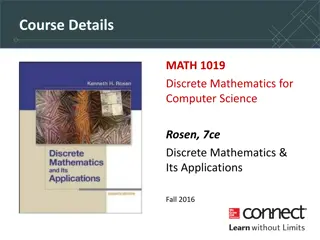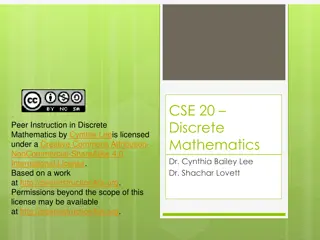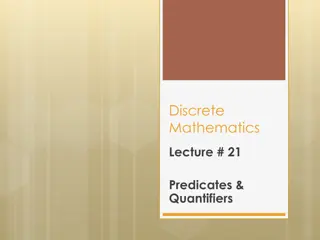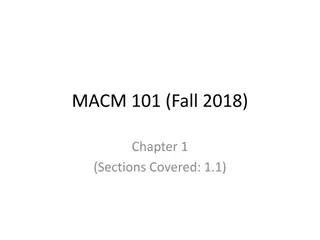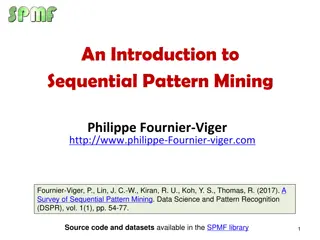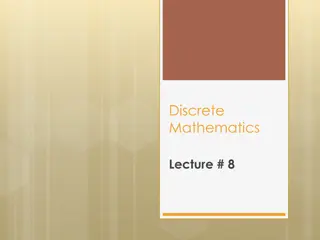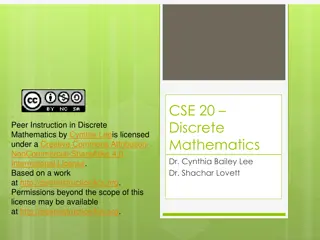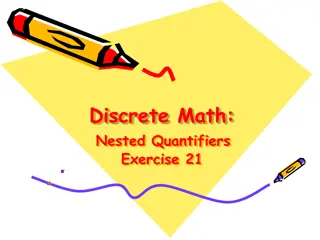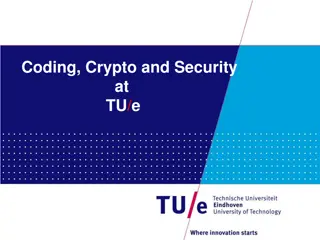Introduction to Discrete Mathematics: MACM 101 Overview
Discrete Mathematics course MACM 101 with Lecturer Binay Bhattacharya covers topics such as continuous vs. discrete math, course information, grading criteria, and more. The course emphasizes mathematical techniques for discrete math and its relevance in computer science. With insights into lectures, office hours, quizzes, and exercises, students gain a comprehensive understanding of the subject.
Download Presentation

Please find below an Image/Link to download the presentation.
The content on the website is provided AS IS for your information and personal use only. It may not be sold, licensed, or shared on other websites without obtaining consent from the author.If you encounter any issues during the download, it is possible that the publisher has removed the file from their server.
You are allowed to download the files provided on this website for personal or commercial use, subject to the condition that they are used lawfully. All files are the property of their respective owners.
The content on the website is provided AS IS for your information and personal use only. It may not be sold, licensed, or shared on other websites without obtaining consent from the author.
E N D
Presentation Transcript
Discrete Mathematics MACM 101 Binay Bhattacharya binay@cs.sfu.ca Introduction
Borrowed some slides from Prof. Bart Selman slides: www.cs.cornell.edu/courses/cs2800/
Overview Course Information Course themes, goals Syllabus
Course Information Lectures: Mon, Wed, and Fri 10:30 11:20 Location: K9500 Lecturer: Binay Bhattacharya Office: TASC I 8017 Phone: 778-782-3133 Email: binay@cs.sfu.ca Course Web site: www.cs.sfu.ca/~binay/2015/macm101/D1 Course information handout is available at the site.
Grading Participation regular attendance of the classes and tutorials working lots of exercises from the text taking advantage of the office hours overall involvement in the course
Grading Quiz 5- to 6 quizzes about 30 minutes long test will be given during the tutorial about a week prior to the quiz, a list of practice questions relevant to the quiz will be handed out. Exams closed-book and closed-notes
Other Office hour (Monday, Friday 12:30 2:00) feel free to stop by whenever you have a question, particularly if you are having trouble Catching up is very difficult once you get behind Exercises solve as many problems as possible. odd numbered questions in the text are solved ask TA or the instructor for help.
What is MACM 101 about? Continuous vs Discrete Math Why is it computer science? Mathematical techniques for Discrete Math
Continuous vs Discrete Continuous Mathematics Objects vary continuously Example: analog wristwatch: from analog perspective, between 10:30 am to 10:31 am there are infinitely many possible times Differential equations
Continuous vs Discrete Discrete Mathematics Objects vary in a discrete way Example: digital wristwatch: from analog perspective, between 10:30 am to 10:31 am there are infinitely finitely many possible times. A digital watch does not show split seconds. Integers --- core of discrete mathematics Computer science computers are digital.
What is MACM 101 about? Why is it computer science?
Number Theory: RSA and Public-key Cryptography Alice and Bob have never met but they would like to exchange a message. Eve would like to eavesdrop. E.g. between you and the Bank of America. They could come up with a good encryption algorithm and exchange the encryption key but how to do it without Eve getting it? (If Eve gets it, all security is lost.) CS folks found the solution: public key encryption. Quite remarkable that that is feasible.
Automated Proofs: EQP - Robbin s Algebras are all Boolean A mathematical conjecture (Robbins conjecture) unsolved for decades. First non-trivial mathematical theorem proved automatically. The Robbins problem was to determine whether one particular set of rules is powerful enough to capture all of the laws of Boolean algebra. One way to state the Robbins problem in mathematical terms is: Can the equation not(not(P))=P be derived from the following three equations? [1] P or Q = Q or P, [2] (P or Q) or R = P or (Q or R), [3] not(not(P or Q) or not(P or not(Q))) = P. [An Argonne lab program] has come up with a major mathematical proof that would have been called creative if a human had thought of it. New York Times, December, 1996 http://www-unix.mcs.anl.gov/~mccune/papers/robbins/
Coloring a Map How to color this map so that no two adjacent regions have the same color?
Graph representation Coloring the nodes of the graph: What s the minimum number of colors such that any two nodes connected by an edge have different colors?
Probability and Chances Importance of concepts from probability is rapidly increasing in CS: Randomized algorithms primality testing; Google s PageRank, just a random walk on the web!) in computation, having a few random bits really helps! Machine Learning / Data Mining: find statistical regularities in large amounts of data. Natural language understanding dealing with the ambiguity of language
Probability and Chances Computer scientist have recently found a remarkable way to do this: holographic proofs Ask the author of the proof to write it down in a special encoding (size increases to, say, 50,000 pages of 0 / 1 bits). You don t need to see the encoding! Instead, you ask the author to give you the values of 50 randomly picked bits of the proof. (i.e., spot check the proof ). With almost absolute certainty, you can now determine whether the proof is correct of not! (works also for 100 trillion page proofs, use eg 100 bits.) Aside: Do professors ever use spot checking ? Started with results from the early nineties (Arora et al. 92) with recent refinements (Dinur 06). Combines ideas from coding theory, probability, algebra, computation, and graph theory. It s an example of one of the latest advances in discrete mathematics. See Bernard Chazelle, Nature 07.
Goals of MACM 101 Introduce students to a range of mathematical tools from discrete mathematics that are key in computer science. How to write statements correctly. How to read and write theorems. Areas: Set Theory Logic and Proof Counting Relations Functions Number Theory
Goals of MACM 101 Introduce students to a range of mathematical tools from discrete mathematics that are key in computer science. How to write statements correctly. How to read and write theorems. Areas: Set Theory Logic and Proof Counting Relations Functions Number Theory Note: Learning to do proofs from watching the slides is like trying to learn to play tennis from watching it on TV! So, do exercises!
